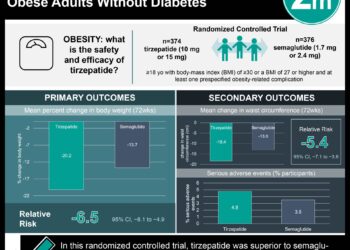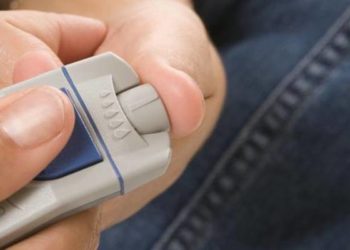Trends in obesity-related behaviors indicate potential successful interventions
Image: PD
1. Television viewing habits and consumption of sweetened beverages among adolescent participants decreased while increases in exercise and consumption of fruits and vegetables have been seen between 2001 and 2009.
2. Adolescent BMI increased from 2001-2005; however, no significant change in BMI was noted between 2005 and 2009.
Evidence Rating Level: 2 (Good)
Study Rundown: Obesity remains a significant, international public health concern , particularly among adolescents; however, a recent plateau of obesity prevalence has been noted. Preventable causes of obesity, including sedentary behavior, decreased physical activity, and diet have been targets of national campaigns. This study surveyed U.S. adolescents to evaluate how these behaviors have changed in the context of stable obesity rates. Different adolescent groups were recruited in 2001-2002, 2005-2006 and 2009-2010 and asked to complete the Health Behavior in School-aged Children (HBSC) as well as to report their height and weight. The HBSC evaluates multiple health behaviors including dietary intake, physical activity, and media use as a proxy for sedentary activity. Over the three study periods, reported physical activity among adolescents increased significantly, television viewing decreased significantly, and there was no significant difference between group computer usage. Additionally, the consumption of sweets and sugared drinks decreased. BMI was not significantly different between participants during the last two time periods. While these variables suggest that public health efforts to reduce obesogenic behaviors may be successful, the authors note that most adolescents surveyed did not meet the American Academy of Pediatrics’ recommended level of physical activity (>60 minutes per day), television viewing (< 2 hours per day) or fruit/vegetable intake. This study is limited in its reliance on self-report, and lack of matching of participants across the three study periods. Further research is needed to examine the effects of individual health behaviors on obesity risk.
Click to read the study in Pediatrics
Relevant Reading: Longitudinal and secular trends in physical activity and sedentary behavior during adolescence
In-Depth [retrospective cohort]: This study evaluated representative samples of U.S. adolescents in grades 6-10 during three study periods: 2001-2001 (n = 14,818), 2005-2006 (n = 9,227) and 2009-2010 (n = 10,993). Outcomes of interest were evaluated based on the HBSC self-report survey and included physical activity, media consumption, and diet. Adolescents reported significantly more physical activity between the 2002 and 2009 time periods (4.33 vs. 4.53, p < 0.001), as well as significantly decreased total and weekend TV watching (3.06 vs. 2.38, p < 0.001 for both). Sweet consumption and soft drink consumption decreased significantly over time (4.7 vs. 4.1 and 4.85 vs. 4.18, p < 0.001 for both). Average reported BMI was higher in girls when compared to boys (p = 0.001) and older adolescents when compared to younger adolescents (p < 0.001) across all time periods. Between 2002 and 2006, average adolescent BMI increased (p < 0.001); however, between 2006 and 2009 no significant increase in BMI was noted.
By Emilia Hermann and Leah H. Carr
More from this author: AAP urges bottle feeding over breastfeeding in mothers with HIV, Pediatric influenza burden remains high despite new vaccination recommendations, Cow’s milk consumption linked to increased vitamin D and decreased iron stores in early childhood
© 2013 2minutemedicine.com. All rights reserved. No works may be reproduced without written consent from 2minutemedicine.com. Disclaimer: We present factual information directly from peer reviewed medical journals. No post should be construed as medical advice and is not intended as such by the authors or by 2minutemedicine.com. PLEASE SEE A HEALTHCARE PROVIDER IN YOUR AREA IF YOU SEEK MEDICAL ADVICE OF ANY SORT. Content is produced in accordance with fair use copyrights solely and strictly for the purpose of teaching, news and criticism. No benefit, monetary or otherwise, is realized by any participants or the owner of this domain.







